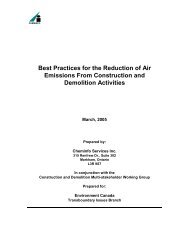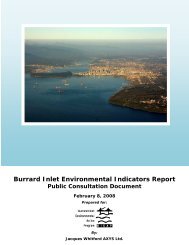Dredge Management Guidelines - the BIEAP and FREMP Website
Dredge Management Guidelines - the BIEAP and FREMP Website
Dredge Management Guidelines - the BIEAP and FREMP Website
You also want an ePaper? Increase the reach of your titles
YUMPU automatically turns print PDFs into web optimized ePapers that Google loves.
Appendix 4<br />
Upl<strong>and</strong> Disposal Requirements<br />
(Source: Ministry of Environment, L<strong>and</strong>s & Parks)<br />
A map is required that clearly indicates <strong>the</strong> area to be dredged <strong>and</strong> <strong>the</strong> accompanying text must note<br />
<strong>the</strong> amount of material to be removed, <strong>the</strong> method of removal, <strong>and</strong> potential sources of contamination<br />
in <strong>the</strong> vicinity of <strong>the</strong> work.<br />
The number of samples required to characterize quantities of materials to be excavated is based on<br />
recommendations in <strong>the</strong> Environment Canada document Interim Contaminant Testing <strong>Guidelines</strong> for<br />
Ocean Disposal Pacific <strong>and</strong> Yukon Region dated March 2000 (see Appendix 5) as follows:<br />
Quantity (m 3 )<br />
0 – 5000<br />
5000 – 20000<br />
20000 – 100000<br />
Number of Samples Required<br />
This intensity of sampling is intended to “screen” for contaminants <strong>and</strong> more intensive sampling may<br />
be required should significant contamination be suspected or encountered. It should also be noted<br />
that <strong>the</strong> samples obtained are expected to be surface s<strong>and</strong>s <strong>and</strong> representative for <strong>the</strong> area to be<br />
dredged (i.e. sampling locations spaced across <strong>the</strong> dredge area). Should contamination at depth within<br />
<strong>the</strong> s<strong>and</strong>s be suspected <strong>the</strong>n s<strong>and</strong> core samples may be required.<br />
Analytical tests performed on <strong>the</strong> s<strong>and</strong> samples should be done at <strong>the</strong> proponent’s laboratory of choice<br />
<strong>and</strong> at cost borne by <strong>the</strong> proponent. The results of <strong>the</strong>se tests must be summarized in a Contaminant<br />
Testing Report <strong>and</strong> submitted to MELP. Tests should be chosen to reflect potential contamination from<br />
local sources. For screening purposes it is suggested that a metals package test (analyzes for about 20<br />
metals) <strong>and</strong> a hydrocarbon test (PAHs are fine but <strong>the</strong> TEH test - total extractable hydrocarbons - would<br />
likely be more cost effective) be done. O<strong>the</strong>r tests, such as for antisapstain chemicals as may be used<br />
at sawmills, may be required depending on sources of contamination in <strong>the</strong> vicinity of <strong>the</strong> area to be<br />
dredged.<br />
The question typically being asked is whe<strong>the</strong>r <strong>the</strong> material being dredged is suitable for disposal onto<br />
l<strong>and</strong>. The indicated s<strong>and</strong> quality is evaluated against <strong>the</strong> Contaminated Sites Regulations. By <strong>the</strong>se values<br />
it is determined whe<strong>the</strong>r <strong>the</strong> material is suitable as l<strong>and</strong>fill <strong>and</strong>/or is consistent with municipal<br />
zoning <strong>and</strong> Official Community Plan designations.<br />
Proponents should refer to <strong>the</strong> Contaminated Sites Regulation (CSR) Technical Guidance documents<br />
titled Site Characterization <strong>and</strong> Confirmatory Testing <strong>and</strong> Statistical Criteria for Characterizing a Volume<br />
of Contaminated Material. Fur<strong>the</strong>r proponents seeking to deposit sediments to <strong>the</strong> upl<strong>and</strong>s need to be<br />
aware of <strong>the</strong> CSR st<strong>and</strong>ards in Schedules 4, 5, <strong>and</strong> 6 of <strong>the</strong> CSR <strong>and</strong> must obtain a Soil Relocation<br />
Agreement if <strong>the</strong> sediments are to be moved off site <strong>and</strong> exceed limits in Schedule 7 of <strong>the</strong> CSR.<br />
45 Appendix 4<br />
3<br />
6<br />
8
















